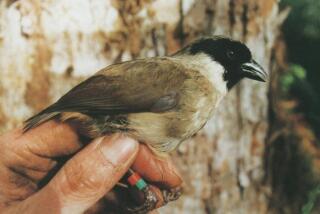Chinaâs River Dolphins Face Doom
WUHAN, China â Here are some of the things that the Yangtze River dolphin is not:
It is not black and white and furry. It does not sit in adorable poses and chew on bamboo shoots. It is not the focus of a worldwide campaign to save it from extinction.
In short, the large freshwater whitefin dolphin--known here as the baiji dolphin--is not a giant panda, Chinaâs most famous endangered species.
But while the panda population appears to have stabilized at about 1,000 animals in the misty Sichuan mountain valleys where it lives, the Yangtze River dolphin is dying off at an alarming rate. Biologists believe that fewer than 100 of the dolphins remain in the lower reaches of the great Chinese river, the only place on Earth where the 300- to 500-pound aquatic mammals with long, beak-like snouts are found.
Their survival is so uncertain that, when Wang Ding, the 39-year-old director of the river dolphin program at Chinaâs Institute of Hydrobiology here, went out with 500 searchers earlier this month to conduct the annual census, he was afraid he would find none at all.
On the first day out, the searchers, surveying the river on tiny 4.5-horsepower fishing boats, spotted six of the dolphins. After a week they counted 21. Thousands once frolicked in Chinaâs most famous river, inspiring the countryâs greatest poets to create myths and legends about river goddesses and mermaids. But Wang was relieved.
âI was very worried about what might happen,â said Wang, a physicist who fell in love with the dolphin when he was sent here by the government in 1986 to conduct acoustic experiments on a captured male. âFrankly, I was excited that we found some still alive. This species faces very serious threats in the river. We are running out of time to save it.â
The Yangtze River dolphin (Lipotes vexillifer) is the rarest of all cetaceans, the family that includes whales, dolphins and porpoises. Their habitat is in one of the worldâs busiest and most industrialized rivers.
The dolphins are threatened by fishermen, who snag the mammals with their nets and giant hooks, and by the propeller screws of oceangoing ships that ply the lower reaches of the Yangtze. The acute sonar hearing of the practically blind dolphins is thrown off by the noise of the river traffic.
A new threat to their survival was posed earlier this month, when workers completed the first phase of the massive Three Gorges Dam, effectively blocking the dolphinsâ path to the upper Yangtze.
âBased on what we know,â said Robert Brownell, chief of the marine mammal division of the Southwest Fisheries Science Center in La Jolla, âit doesnât seem like this dolphin is going to make it.
âSome people have speculated it might last another 10 to 15 years, but, biologically speaking, they may be dead before that time,â said Brownell, explaining that animals can be reduced in number to the point where they can no longer effectively propagate their species.
Brownell is one of a group of international biologists who met in Wuhan in 1986 to map out a strategy to save the animal.
Conditions in the Yangtze River are so inhospitable for the dolphin that biologists have given up trying to improve the river habitat to save the species. Instead, they have concentrated their efforts in a last-ditch attempt to create a âsemi-natural preserveâ for the remaining dolphins in an oxbow of the river at Shishou, about 150 miles upriver from Wuhan.
The Shishou oxbow is about 13 miles long and is 1/2 to 1 mile wide, large enough to maintain and support the existing population.
Several months a year, during the flooding season, it receives a substantial flow of water from the riverâs main channel and has plentiful supplies of the fish the dolphins eat.
The latest rescue plan is to net and capture the remaining dolphins and transport them to the Shishou oxbow. The biologists were hopeful in 1995 when they managed to capture a female dolphin and place her in the preserve. But the first effort ended in disaster less than a year later when the female died after becoming snagged in the net separating the preserve from the main river.
Since then, the Chinese government river dolphin program has begun construction of a barrier made of concrete and steel mesh, which poses less threat to the dolphins but still allows water and fish to enter.
The main problem, said Wang, acting director of the Wuhan Baiji Conservation Foundation, is money.
The Chinese biologists do not have enough money to finish the barrier and to pay for the relocation of several hundred fishermen who now live on the river oxbow.
Wang said he often wishes that some of the international concern over the beloved giant panda could be transferred to the river dolphins.
âWe are trying our best to save it, but this animal is much more endangered than the panda,â he said.
If these desperate efforts fail, the last living Yangtze River dolphin could be Qiqi, a 20-year-old male captured in 1980 after he was found bleeding and nearly dead from wounds inflicted by large ârolling hooksâ used by river fishermen.
The biologists nursed the seriously injured Qiqi back to health. For a while, they believed that they had managed to find Qiqi a mate, a younger female named Zhenzhen.
Although they never reproduced, the pair appeared delighted with each other. But Zhenzhen died suddenly in 1988 during an unusual cold spell that froze the water in the dolphinsâ unprotected tank. After the incident, the Chinese river experts built a new indoor tank for Qiqi with a water-purification and temperature-control system.
For a few weeks after Zhenzhen died, Wang said, he recorded terribly sad whistling calls coming from Qiqi.
âThey were courting calls,â Wang said. âHe was looking for company.â
Suddenly, the calls stopped. Wang said he has not heard them again.
(BEGIN TEXT OF INFOBOX / INFOGRAPHIC)
Endangered Dolphins
The baiji dolphin of the Yangtze River is rapidly disappearing. Scientists estimate that fewer than 100 of the freshwater mammals remain. Thousands once thrived in Chinaâs most famous river, where they now are threatened by pollution, river traffic, fishing and the Three Gorges Dam project. A rescue plan for the endangered dolphins entails capturing them and transporting them to a preserve in the river at Shishou.
The Baiji Dolphin (Lipotes vexillifer)
Weight: 300-500 pounds
Length: 6 to 7 feet
Appearance: Pale blue-gray in the dorsal region and white ventrally.
Diet: Freshwater fish
Range: 1,000 miles from mouth of Yangtze River to Three Gorges
Behavior: Usually found in pairs in larger social units of 10 animals
Lifespan: 25-30 years
Average dive: 20 seconds (can dive up to 2 minutes)
****
For more information:
Wuhan Baiji Conservation Foundation
Institute of Hydrobiology
Chinese Academy of Science
Wuhan, Hubei 430072
China
To contact the foundation electronically, address e-mail to:
More to Read
Sign up for Essential California
The most important California stories and recommendations in your inbox every morning.
You may occasionally receive promotional content from the Los Angeles Times.










